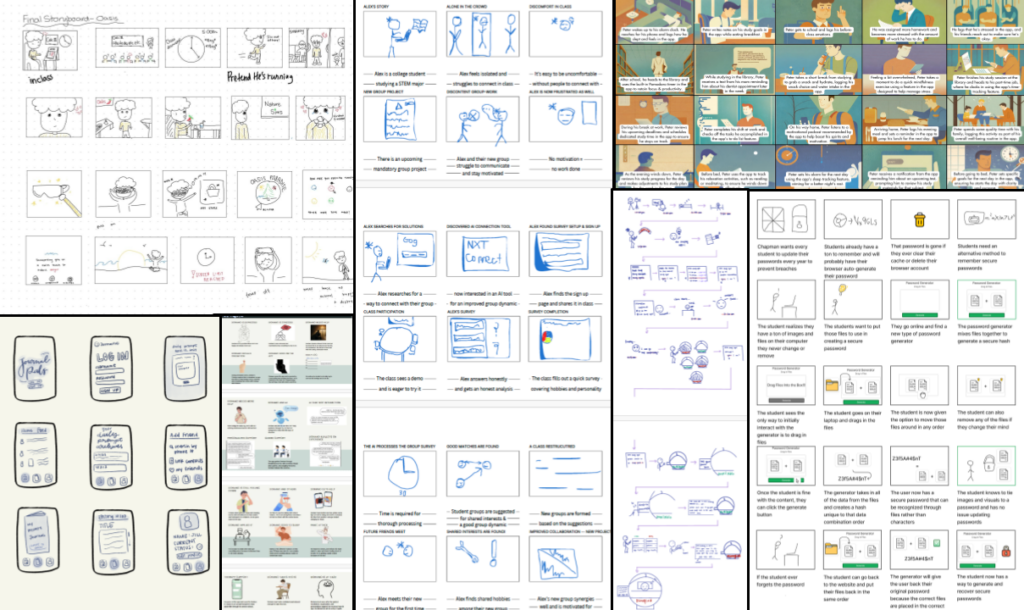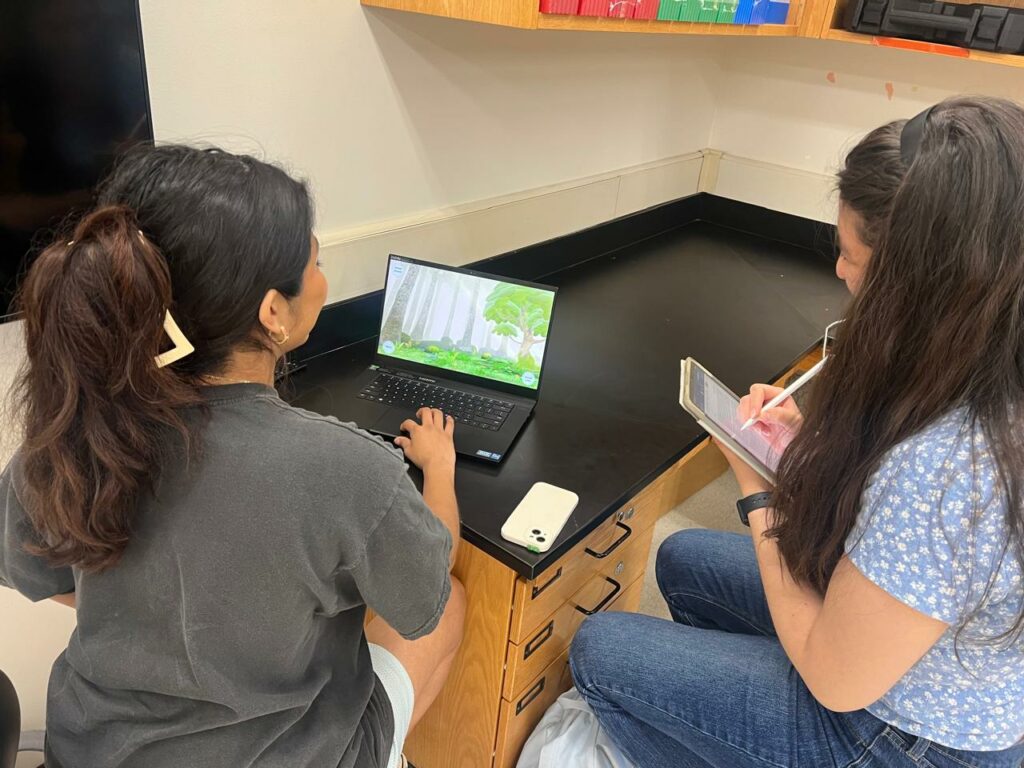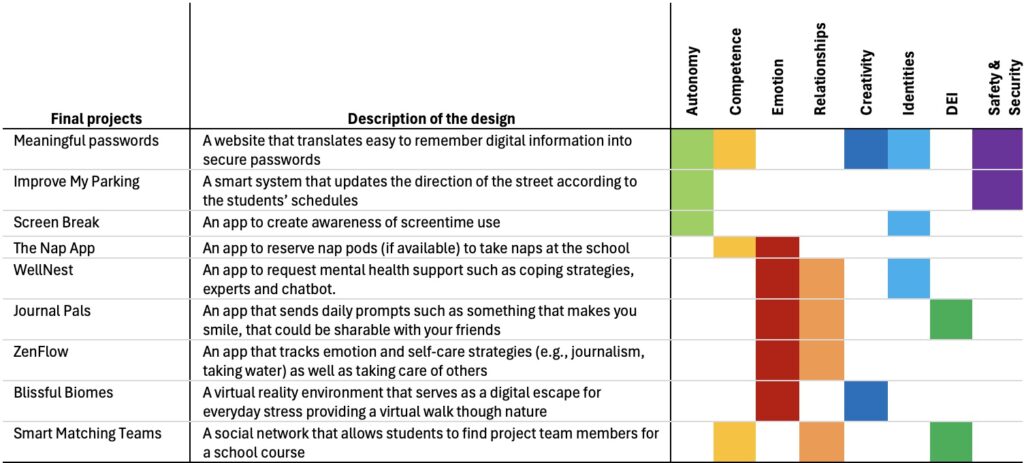As an instructor at the Fowler School of Engineering at Chapman University, I teach an undergraduate Human-Computer Interaction (HCI) class regularly. This class is a hands-on, project-based course that teaches students the fundamental principles of HCI and Interaction Design. The course aims to enable students to apply interaction design methodology—discovering requirements, designing alternatives, prototyping, and evaluating—to develop technology that puts the user’s needs upfront.
In the Spring 2024 semester, our class goal was to design technology that supports the digital well-being of students. Embracing a human-centered approach, our projects were designed for, by, and with Engineering students, ensuring that the solutions developed genuinely addressed their needs. Teams of three to four students collaborated, each focusing on a specific aspect of well-being, such as safety and security, empowerment, competence, creativity, emotion, and social connection.
Discovering Requirements
The project-based part of the course starts with discovering requirements, a critical phase where students frame the design challenge. This involved reading about the RITEC-8 framework in the Understanding Well-Being in Digital Spaces guide and selecting two topics that resonated with them. Students reflected on how these topics aligned with their long-term and short-term goals, conducted observations, and interviewed their peers to better understand well-being challenges. This comprehensive approach ensured the projects were grounded in real-world experiences and needs.
“So I like the structure and the format [the class] gave us because, I think, I liked having that structure and guidance because even though we were given just well-being as a whole, it let us kind of figure out things like subtopics underneath it.”
The RITEC-8 framework helped students define the scope of their projects.
“So, I think for us [having the framework] really get tour our point with … to narrowing out the things we want to do.”
Prior to discussing the framework, most students had an understanding of digital well-being that was focused on “undesirable” attributes, such as wasting time on social media or issues around emotional management. The framework allowed them to think broadly about well-being while focusing on specific, manageable outcomes. This balance was crucial in preventing the projects from becoming too generalized or narrowly focused.
Designing Alternatives and Prototyping
Once the requirements were clearly defined, students moved on to designing alternatives and prototyping. This stage was characterized by creativity and collaboration. Students employed various brainstorming techniques and developed low to medium-fidelity prototypes, including sketches and storyboards. These storyboards were shared among teams, facilitating cross-team feedback and diverse perspective .


Each team member developseda storyboard proposing a socio-technical solution to support one or more well-being outcomes. The iterative feedback process ensured that the solutions remained aligned with the initial requirements. This alignment was crucial for maintaining the project’s focus and ensuring that the final product addressed the identified problems effectively.
“At least for our group, we were all very torn between what we idea we want to pursue , but in the end, we ended up deciding to vote based on [what supports best the framework outcomes]”
“This makes you more aware about … restrictions that you may not be aware of … for example, safety it is important for well-being”
Evaluation
The evaluation phase involved a peer’s usability testing and heuristic evaluation focusing on both usability and well-being outcomes. Students created digital versions of their storyboard solutions using tools like Figma and Canva. The class functioned as a research team, with students acting as both designers and evaluators. Usability testing with peers provided practical insights, while the usability heuristic evaluation ensured that the prototypes adhered to established usability principles, and the RITEC-8 frameworks were used as heuristics to assess well-being outcomes. This dual focus ensured that prototypes were user-friendly and effective in promoting well-being.

Eight prototypes were evaluated, each addressing different well-being outcomes (See Table 1 below). For instance, “Meaningful Passwords” focused on security by translating easy-to-remember digital information into secure passwords, while “Blissful Biomes” offered a virtual reality environment for stress relief. This diverse range of projects highlighted the multifaceted nature of well-being and the various ways technology can support it.

Incorporating Well-Being into HCI class
Incorporating the RITEC-8 Framework into product design requires an understanding of the relationships between different well-being outcomes. Through this course, we have explored the intersection of technology and well-being through the lens of our Human-Computer Interaction class. By emphasizing a human-centered approach, our students can develop innovative solutions that address real-world well-being challenges, demonstrating the power of thoughtful design in improving our digital lives.
Moving forward, our goal is to create templates that support students through all stages of interaction design. These templates will include clear reflection questions to help students think critically about the well-being outcomes their projects aim to achieve.
While today’s engineering students are increasingly mindful of their overall well-being and strive to balance their personal and academic lives, the concept of digital well-being is still emerging. Engineering curricula should emphasize the importance of “Human-Centered Engineering,” training future engineers to address real-world problems inclusively and with a commitment to social good. By integrating a stronger focus on well-being in digital spaces, we can consider a holistic approach to developing digital experiences that benefit children and society. This approach will mitigate potential risks while fostering healthier digital habits and enhancing overall well-being.

Franceli Cibrian, PhD, is an Assistant Professor at the Dale E. and Sarah Ann Fowler School of Engineering at Chapman University. Her research lies at the intersection of Human-Computer Interaction (HCI), assistive technology, ubiquitous computing, pervasive healthcare, and Artificial Intelligence (AI). She participated in the 2024 Well-Being by Design Fellowship.